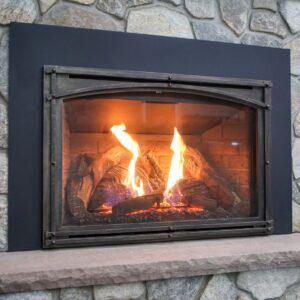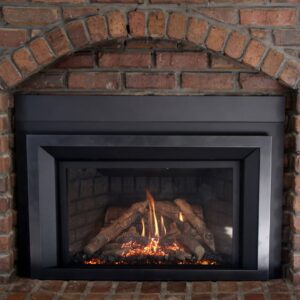Converting Your Wood Fireplace to Gas
Nothing compares to a wood-burning fireplace when it comes to aesthetics, charm, and ambiance. However, wood-burning fireplaces have a lot of issues. They’re terribly inefficient as a heat source, they can be a pain in the you-know-what to use and maintain, and if you don’t stay on top of maintenance, they can be a serious fire hazard. That’s where gas fireplaces come in.
If your fireplace is more of a decoration now than a heat source, converting it to gas might answer, and it’s not as complicated as you might think.
Why Bother Switching to Gas?

Convenience
This is the big one. With a gas fireplace, you can literally press a button or flip a switch and bam, instant fire. No kindling, no newspaper, no matches, no waiting. You don’t even have to get up from the couch, especially if you have a remote control.
Cleanliness
Wood fires are dirty. They leave behind ashes, soot, and creosote, which can build up in the chimney and create a fire hazard. Gas? Super clean. No sweeping out charred logs the next morning. No smoky after smell clinging to your furniture and clothes.
Efficiency
As mentioned, traditional fireplaces are notoriously inefficient. Most of the heat goes right up the chimney. Gas fireplaces are designed to provide consistent heat, and many are equipped with blowers that circulate the warm air throughout the room, making them cozy and energy smart.
Environmental Impact
Gas burns cleaner than wood. If you want to shrink your carbon footprint just a little, converting to gas is a solid move.
Year-Round Usability
Because gas fireplaces can be turned on and off instantly, you’re more likely to use them throughout the year. Want a cozy vibe on a rainy spring day without overheating the house? Gas makes that possible.
How Hard Is It To Switch?
The good news is that converting a wood fireplace to gas is very doable. There are two main types of gas fireplace options:
Gas Logs
These are decorative ceramic logs that mimic real wood. They sit inside the existing firebox and are mainly for looks, although they do produce heat.
Gas Inserts
These are sealed units that are installed inside the fireplace and connected to a gas line. Inserts are more efficient and better for heating larger spaces, and look more like a traditional fireplace.
How tricky the conversion is depends on what you’ve already got going on in your fireplace setup. If your chimney is in decent shape and you already have a gas line nearby, the project is usually straightforward. If not, there may be some extra steps involved, like lining the chimney or running a new gas line.
 Should You DIY This?
Should You DIY This?
In a word? No.
Gas lines are not a weekend warrior project. Hooking up gas incorrectly can lead to leaks, fires, or explosions. You want someone who knows how to properly install the gas line, ensure the ventilation is safe and up to code, test for leaks, get the necessary permits, and can handle the local building codes and inspections.
A licensed professional will ensure your new fireplace looks great, runs safely, and doesn’t void your homeowners’ insurance. Plus, they can help you pick the right system for your space and style.
Converting your wood-burning fireplace to gas is a smart move if you’re tired of the hassle and mess of burning wood or if you want a more efficient heating source. While it’s not the kind of project you want to tackle on your own, hiring a highly qualified professional makes the process surprisingly painless.
Contact the fireplace experts at Motown Fire or visit our showroom located at 50760 Metzen Dr., Chesterfield TWP, MI, where you can see working fireplaces and speak to our friendly staff about which option is right for you.



